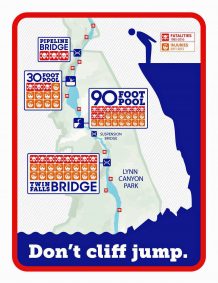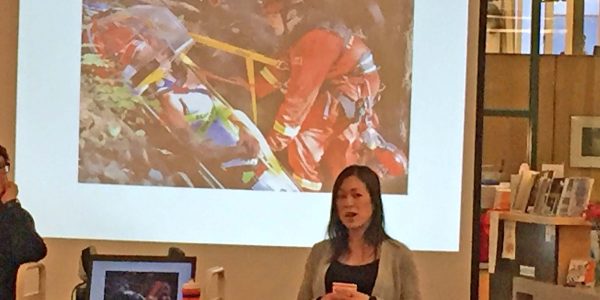LGH Emergency Department doc joins anti-cliff jumping forces on the North Shore
Dr. Jatina Lai, an emergency department physician at Lions Gate Hospital, was part of an emotional presentation last Friday at Argyle Secondary on the risks of cliff jumping in Lynn Canyon.
Jatina joined representatives from the District of North Vancouver Fire & Rescue Services, the RCMP, and North Shore Search & Rescue and spoke to about 80 students from the school’s Digital Media Academy and Social Justice class at a brainstorming event called an Ideas Slam.
Talk part of public awareness campaign
Organized by the District of North Vancouver, the event was the first step in a collaboration between the District and the students of the Digital Media Academy to develop a public awareness campaign aimed at cliff jumpers for spring and summer 2017.
Despite the District posting eye-catching signs in Lynn Canyon Park this past summer warning against cliff jumping, teens and young adults continue to take risks, says Mairi Welman, Manager, Strategic Communications and Community Relations.
Jatina quoted hard-hitting statistics on speed of impact versus height of the jump. It caught the teens’ attention.
“I likened it to slamming into a wall at 40 km/hour when you jump from a six-metre height,” she says. “You can break bones, damage your spinal chord… If you jump and land flat on your back or even on an angle, it can cause a fracture or spine injury.”
Presentation makes an impact

The District of North Vancouver has posted three injury and death signs at three critical jumping points in Lynn Canyon.
Jatina’s brief but pointed presentation had an impact.
“The information she shared made an impression on the kids,” said Mairi. “I heard some of the boys mentioning the ‘speed at impact’ stats she provided. It was a real eye opener.”
Jatina also explicity detailed what happens to an individual when they are brought to the ED after a cliff jumping accident.
Part of the discussion also focused on Cole Marsh, the 17-year-old Coquitlam teen who died after plunging into the cold waters of Lynn Canyon last March. Because of the high water and speed of the river, Cole’s body could not be recovered for three weeks. It’s estimated that North Shore Rescue volunteers put in almost 2,000 hours in the search and highly technical recovery of Cole’s body.
“I didn’t get to see Cole. We don’t see all the injured at the hospital because they’ve already passed away,” Jatina told the students.
Jatina, who lives next door to Lynn Canyon and sees people cliff jumping on a daily basis in the summer, was at home the day Cole’s body was recovered.
“There was a lot of action in the neighbourhood that day. It was quite shocking to see,” says Jatina, who had just moved to Lynn Valley. “The most important thing I wanted to get across is that this is not like mountain biking or skiing, which do come with inherent risks, but not at the same level as cliff jumping. The risk of injury and death is a lot higher. We see a lot of kids in the ED who’ve done stupid, preventable things, especially around grad. They need to listen to their inner voice. If it’s telling them ‘this is not a good idea,’ don’t do it.”


BC
Great idea! My uncle was fire captain for many years up in Lynn Valley and for him pulling bodies out of the canyon was a regular occurrence every summer.
They need to have this presentation broadcast to all schools at some point and madeavailable at community centres etc because a high percentage of accidents involved summer visitors to BC & Canada or from other municipalites other than North Vancouver.
Lori Baker
Nice work Jatina! Thanks for taking the time to do that.
Best
Lori